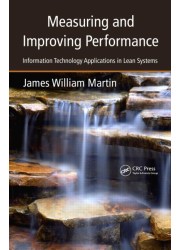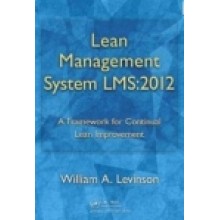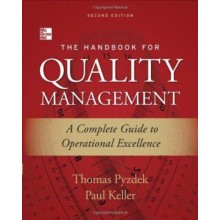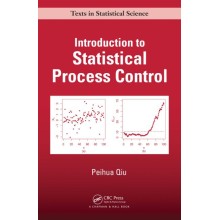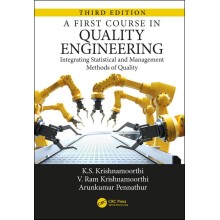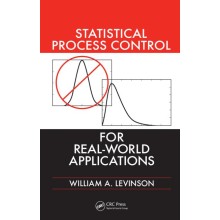Measuring and Improving Performance: Information Technology Applications in Lean Systems
Quantity:
-
Add to Compare
As a pioneer in Lean improvement methods, Jim Martin was among the first to suggest that truly successful Lean initiatives are those applied across every facet of an organization, not just on the shop floor. Building on this concept, Martin demonstrates that one of the most effective ways to implement operational improvements across an organization is to approach it through the resource that permeates every facet of a modern organization—information technology.
Measuring and Improving Performance: Information Technology Applications in Lean Systems explains how the effective use of Lean project management methodologies can increase the productivity of information system deployment in service and manufacturing organizations. Starting with an overview of Lean and agile project management principles, the author walks readers through the implementation of Lean practices across key aspects of IT systems.
Created to provide Lean and Six Sigma practitioners with a clear understanding of the important concepts related to the creation and modification of software to support process improvement activities across Lean systems, this reference book:
- Details how to apply Lean principles to IT systems on a global scale
- Explains how to design IT systems capable of meeting evolving customer needs and expectations
- Covers several project management methods including agile project management (APM), agile unified process (AUP), SCRUM, extreme programming (EP)
- Identifies the operational issues that can help project execution and those that can hinder it
Complete with roadmaps and checklists, this book will help busy IT and Lean professionals discover more efficient ways to monitor business activity, gather business intelligence, manage and analyze business processes, and ultimately—increase overall operational efficiency.
Table of Contents
IT PROJECT MANAGEMENT CONCEPTS
Highly Structured Project Management
Capability Maturity Models
Highly Structured Project Management
Factors for Managing Project Risk
Classic Project Management Activities
Key Requirements Characteristics
Common Design Issues
Agile Project Management with Scrum
Open Exchange of Information to Stakeholders
Visual Display of Project Information
Provide Rapid Feedback of Project Status
Use Efficient Design Methods
Verify and Translate User Requirements
Develop Multigenerational Designs
End-User Control
PROCESS IMPROVEMENT METHODS
Accelerating Organizational Change
Change Readiness
Key Change Tools and Methods
Developing Project Charters
Team Authority and Clarity
Key Stakeholder Analysis
Analyzing Promoting and Restraining Factors
Analyzing Organizational Structures
Managing Project Risk and Issues
Planning Project Communications
Managing Lean IT Projects
Translating Customer Requirements
Key Design Goals
Translating Customer Requirements
Kano Needs
Value Expectations
Collecting the Customer Information
Specifications
Reasons for Poor Specification of Requirements
Translating Critical-to-Quality (CTQ) Requirements
Using the Analytical Hierarchy Process (AHP)
Analytical Hierarchy Process (AHP) Ranking Scale
Prioritizing Design Alternatives Using a Pugh Matrix
Mapping Specifications to Systems
Understanding Lean Concepts
Seven Forms of Waste
Lean Tenets
Lean Versus Agile Project Management (APM)
Reorganize Work Environment
Create a High-Performance Work Team
Understand Customer Value
Develop Metrics and Measurement Systems
Link Work Operations
Level Demand of a Scrum Sprint
Simplify Work
Standardize Work
Apply Mistake-Proofing Methods
Balance the Flow of Work between Team Members
Manage Bottlenecks
Use Transfer Batches
Reduce Setup Time
Maintain System Availability
Implement a Pull Scheduling System
Software Development and Project Support
Development of System Specifications
Capturing Stakeholder Requirements
Use Cases
E-Commerce Example
Key Concepts of Efficient Software Design
Software Quality Assurance
Software Documentation
Configuration Management
Software Testing
Software Deployment and Distribution
PROCESS INTEGRATION
Lean IT Applications in Manufacturing and Service Systems
Information Technology (IT) Applications in Lean Systems
Manufacturing Systems
Enterprise Resource Planning (ERP)
Forecasting
Capacity Requirements Planning (CRP)
Master Production Schedule (MPS)
Quick Response Manufacturing (QRM) Systems
Manufacturing Resource Planning (MRPII)
Manufacturing Automation Protocol (MAP)
Distribution Requirements Planning (DRP)
Warehouse Management System (WMS)
Advanced Shipping Notification (ASN)
Service Systems
Workflow Management (WM)
Enterprise Application Integration (EAI)
Business Activity Monitoring (BAM)
Business Intelligence (BI)
Business Process Modeling and Analysis (BMA)
Business Process Management (BPM)
Business Process Management Suite (BPMS)
Measuring and Improving Performance
IT Governance
Governmental and Industry Standards
Measuring and Improving Performance
Performance Metrics and Dashboards
Measuring Lean IT Project Teams
Measuring Software Creation and Deployment
Measuring the Software Testing Process
Measuring the Performance of Lean Systems
Mapping Project and Design Metrics
Measuring and Improving Performance
Lean IT Applications
Conclusion
Glossary
Appendix: List of Figures and Tables
Index
Write a review
Your Name:Your Review: Note: HTML is not translated!
Rating: Bad Good
Enter the code in the box below:
Copyright © 2014 Engineering Standards Bureau. All Rights Reserved.
Developed By Zoom Into Web


